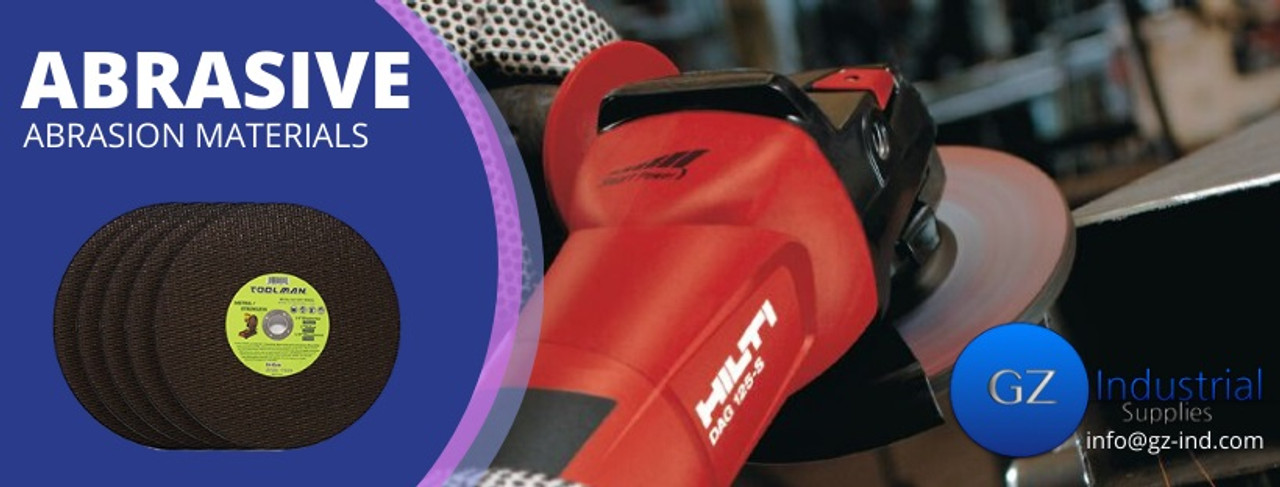TYPES OF ABRASIVES
An abrasive is a material, often a mineral, that is used to shape or finish a workpiece through rubbing, which leads to part of the workpiece being worn away by friction. While finishing a material often means polishing it to gain a smooth, reflective surface. The process can also involve roughening as in satin, matte or beaded finishes. In short, the ceramics which are used to cut, grind and polish other softer materials are known as abrasives.
Abrasive materials are hard crystals that are either found in nature or manufactured. The most commonly used of such materials are aluminum oxide, silicon carbide, cubic boron nitride, and diamond. Other materials such as garnet, zirconium, glass, and even walnut shells are used for special applications.
There are two types of abrasives: NATURAL and MANUFACTURED.
Important natural abrasives, such as emery, corundum, and diamond, are used only in special types of grinding wheels and honing stones. Manufactured or Synthetic Abrasives are now considered superior if not as effective as natural abrasives. The materials of the later are aluminum oxide, silicon carbide, boron carbide, and titanium carbide. Aluminum oxide is used mostly for grinding carbide tools and non-ferrous metals. About 40 percent in a grinding wheel is comprised of abrasive.
Abrasives can either be bonded or coated. Bonded abrasive is attached to a matrix. This matrix is called a binder. It is often clay, a rubber, a resin or a glass. On the other hand, coated abrasives are fixed to a backing material such as cloth, paper, resin, rubber, polyester or even metal. One common example of an abrasive is sandpaper. The abrasives on sandpaper are coated on paper that can be held by the hand. The person can control the smoothing strength of the sandpaper by adjusting the pressure and speed of the hand movement. Abrasives are important since all industries require it. It would not be possible to polish perfectly designed furniture or create complex buildings without their use.
APPLICATIONS OF ABRASIVE:
Applications of abrasives generally fall in the following categories:
1) Cleaning of surfaces and the coarse removal of excess material, such as rough off-hand grinding in foundries.
2) Shaping, as in the form of grinding and tool sharpening.
3) Sizing, primarily in precision grinding
4) Separating, as in cut-off or slicing operations.
For the past 100 years, manufactured abrasives such as silicon carbide and aluminum oxide have largely replaced natural abrasives. Natural diamonds have nearly been supplanted by synthetic diamonds. The success of manufactured abrasives arises from their superior, controllable properties as well as their dependable uniformity.
Both silicon carbide and aluminum oxide abrasives are very hard and brittle, and as a result, they tend to form sharp edges. These edges help the abrasive to penetrate the work material and reduce the amount of heat generated during the abrasion. This type of abrasive is used in precision and finish grinding. Tough abrasives, which resist fracture and last longer, are used for rough grinding.
USES OF ABRASIVES
Industries use abrasives in three basic forms:
1) Bonded to form solid tools such as grinding wheels, cylinders, rings, cups, segments, or sticks.
2) Coated on backings made of paper or cloth in the form of sheets (such as sandpaper), strips or belts.
3) Loose; held in some liquid or solid carrier as for polishing or tumbling, or propelled by force of air or water pressure against a work surface (such as sandblasting for buildings).
Abrasion most frequently results from scratching a surface. As a general rule, a substance is only seriously scratched by a material that is harder than itself. This is the basis for the Mohs scale of hardness in which materials are ranked according to their ability to scratch materials of lesser hardness. Abrasives are therefore usually considered to be refractory materials with hardness values ranging from 6 to 10 on the Mohs scale that can be used to reduce, smooth, clean, or polish the surfaces of other less hard substances such as metal, glass, plastic, stone, or wood. During abrasion, abrasive particles first penetrate the abraded material and then cause a tearing off of particles from the abraded surface. The ease with which the abrasive particles dig into the surface depends on the hardness of the abraded surface; the ease with which the deformed surface is torn off depends on the strength and, in some cases, on the toughness of the material. Between hardness, strength, and toughness, hardness is usually the most important factor determining a material's resistance to abrasion. When two surfaces move across each other, peaks of microscopic irregularities must either shift position, increase in hardness, or break. If local stresses are sufficiently great, failure of a tiny volume of abraded material will result and a small particle will be detached. This type of abrasion occurs regardless of whether the contact of the two surfaces is due to sliding, rolling, or impact. Some forms of abrasion involve little or no impact, but in others, the energy of the impact is a deciding factor in determining the effectiveness of the abrasive. Brittle materials, for example, tend to shatter when impacted and their abrasion may resemble erosion more than fractures.
For more details on Abrasives, please contact us on https://www.gz-supplies.com/contact-us/







